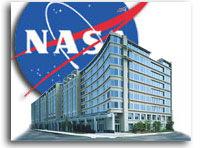Building a Better NASA Workforce: Meeting the Workforce Needs for the National Vision for Space Exploration

Executive Summary (Excerpt)
The Vision for Space Exploration (VSE) announced by President George W. Bush in 2004 sets NASA and the nation on a bold path to return to the Moon and one day put a human on Mars.1 The long- term endeavor represented by the VSE is, however, subject to the constraints imposed by annual funding. Given that the VSE may take tens of years to implement, a significant issue is whether NASA and the United States will have the workforce needed to achieve that vision. The issues range from short-term concerns about the current workforce’s skills for overseeing the development of new spacecraft and launch vehicles for the VSE to long-term issues regarding the training, recruiting, and retaining of scientists and engineers in-house as well as in industry and academia.
Asked to explore science and technology (S&T) workforce needs to achieve the nation’s long- term space exploration vision (see Appendix B for the full statement of task), the Committee on Meeting the Workforce Needs for the National Vision for Space Exploration concluded that in the short term, NASA does not possess the requisite in-house personnel with the experience in human spaceflight systems development needed to implement the VSE. But the committee acknowledges that NASA is cognizant of this fact and has taken steps to correct it, primarily by seeking to recruit highly skilled personnel from outside NASA, including persons from industry and retirees.
For the long term, NASA has to ask if it is attracting and developing the talent it will need to execute a mission to return to the Moon, and the agency must identify what it needs to do to attract and develop a world-class workforce to explore other worlds. A major challenge for NASA is reorienting its human spaceflight workforce from the operation of current vehicles to the development of new vehicles at least throughout the next decade, as well as starting operations with new rockets and new spacecraft.
NASA’s April 2006 Workforce Strategy discussed agency workforce competency trends, identifying an increased need for personnel in five skill areas through 2009.2 These include 150-200 full- time employees in program/project management, 100-150 in systems engineering and integration engineering, and 200-240 in mission operations—numbers driven primarily by the establishment of the Constellation program.3 At the time NASA established those requirements, the agency had a total of approximately 1650 persons in these categories involved in other projects. The committee concluded that although many of the employees required in the mission operations category could be transitioned from the Space Shuttle program, many of the 250-350 full-time employees needed in the program/project management and systems engineering and integration engineering competencies are unlikely to currently reside in the agency and will have to be acquired from industry. NASA last had substantial in-house involvement in human spaceflight systems engineering in the 1970s, during the design phase of the Space Shuttle program, and the people skilled in human spaceflight are now likely to exist only in industry.
Although human and robotic systems are distinct, they do share many management and engineering process as well as system technical characteristics. Given that the bulk of the development activities over the past 10 years have been in robotic spacecraft, NASA needs to leverage the robotic spacecraft workforce skill development opportunities to meet some of the human spaceflight program development skill needs. The committee believes that systems engineering methodology and technical skills acquired from complex robotic spacecraft development can serve as an important base for the transition to systems engineering of human spacecraft.
A problem faced by the committee was a lack of data, as well as differing interpretations of future requirements for certain skills and an absence of information correlating levels of expertise required with the numbers of employees anticipated to be needed. Based on available demographic data, however, the committee concluded that, in the broadest sense, there is no looming national shortage of skilled scientists and engineers to implement the VSE over the long term. For example, the committee saw no evidence of a downturn in the national supply of new talent in aerospace engineering and space sciences. The supply of and the demand for new aerospace workers appear to be relatively well matched at present, as evidenced in part by the fact that salaries in aerospace engineering are not increasing sharply relative to those in other fields.4 Although the committee acknowledges the difficulties in predicting future demand for particular labor skills, it notes that past predictions of substantially increased demand for aerospace workers have not been borne out in reality. However, the committee also notes that both NASA and the aerospace industry employ engineers from many different fields besides aerospace engineering, such as electrical engineering and mechanical engineering, making a comparison of supply and demand for NASA more complicated than it would at first appear.
1 The Vision for Space Exploration initiative was announced by President George W. Bush on January 14, 2004, and is outlined in The Vision for Space Exploration, NP-2004-01-334-HQ, NASA, Washington, D.C., 2004.
2 NASA, National Aeronautics and Space Administration Workforce Strategy, April 2006, pp. 15-16, available at http://nasapeople.nasa.gov/HCM/WorkforceStrategy.pdf.
3 NASA’s Constellation program includes development of the Orion spacecraft, the Ares I and Ares V launch vehicles, and the lunar lander required to return Americans to the Moon. NASA has begun initial development of the Orion and the Ares I, with the goal of conducting the first piloted Orion launch by the middle of the next decade.’








